*Critters we’ve seen on our
2012 trip so far: prairie dog, bison, bighorn sheep, pronghorn antelope, mule
deer, llama, white tail deer, elk, grizzly, coyote, badger, Uinta ground
squirrel, black bear, yellow-bellied marmot, wolf, bullsnake, moose
*Birds we’ve seen on our 2012
trip so far: Western meadowlark, magpie, wild turkey, killdeer, osprey,
red-naped sapsucker, sandhill crane, bald eagle, mountain bluebird
*National Parks/Monuments
visited on 2012 trip so far: 2
[Click on any photo
to enlarge for better viewing.]
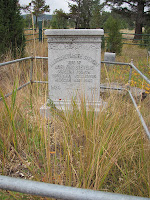
Our time in Yellowstone was drawing to a close, and one
place we wanted to check out was the
Fort Yellowstone
Army Cemetery (ArmyCemetery).
It’s tucked away just off the main road
across from the Mammoth Hot Springs Terraces next to the horse corrals, and
hundreds of people zip by it everyday without realizing it’s even there.
The cemetery is not huge or the site where
any great leaders are buried but is a part of the historical aspect of
Yellowstone of which we’d often heard mentioned.
Nearly 60 people were buried there from 1888
to 1957…U.S. Army soldiers, members of their families, and civilian employees
of the Army and their families.
However from what
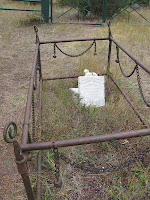
we've read none of the soldiers originally buried are still there as
their bodies were moved to the Little Bighorn Battlefield in
Montana in 1917 when the Army turned control
of the park over to civilian administrators.
The cemetery is overgrown with weeds and many of the markers are
difficult to read (some obviously missing), but the most fascinating thing is
the number of infants and children that are buried there. In fact one tombstone
seems to be forever encircled by the baby’s crib.

Over the past couple of years we had been fortunate to see
so many elk especially during the rut, but the one thing we had failed to
witness was the classic fight or clash between two bulls.
With our time winding down it appeared we
might once again miss this annual display of machismo, but lo and behold one
afternoon in the field outside the RV we finally got to see (and hear)
it.
Usually before a fight begins,
there will be a lot of bugling by the two bulls and thrashing of the ground
with their antlers though these two didn’t do a lot of that preliminary
stuff.
There was a female that both were interested in acquiring for
their harem, and after a bit of chasing by
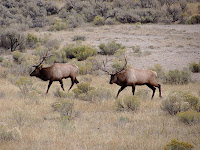 one then the other, the two guys
started their dance. It was odd to watch
initially because it almost seemed like they were buds who decided neither
wanted her and were just going to hang out as they walked nearly side by
side. As we’ve learned, this is all part
of the posturing and ritual. The bulls
will walk side by side, then suddenly turn, walk a little farther, turn again
and begin the fight, locking antlers and shoving each other with all their
might. These two ran at each other and
the sound created when they butted heads was amazing! We were less
one then the other, the two guys
started their dance. It was odd to watch
initially because it almost seemed like they were buds who decided neither
wanted her and were just going to hang out as they walked nearly side by
side. As we’ve learned, this is all part
of the posturing and ritual. The bulls
will walk side by side, then suddenly turn, walk a little farther, turn again
and begin the fight, locking antlers and shoving each other with all their
might. These two ran at each other and
the sound created when they butted heads was amazing! We were less
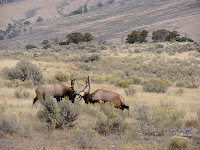 than a hundred yards away and
couldn’t believe how loud it was. Unfortunately this battle didn’t last long. We knew one of the bulls had a pretty good
size harem on the other side of the hill so he must have figured he didn’t need
another gal, but we were thrilled to have finally seen the clash however brief.
than a hundred yards away and
couldn’t believe how loud it was. Unfortunately this battle didn’t last long. We knew one of the bulls had a pretty good
size harem on the other side of the hill so he must have figured he didn’t need
another gal, but we were thrilled to have finally seen the clash however brief.
When we hosted at Capital Reef NP last year, we met
many wonderful people and have stayed in touch with several. One of those couples also happens to make an
annual trek to Yellowstone each fall with a
large group of friends, and we made plans to meet up at some point during their
stay. They camp at Slough Creek
(pronounced slew) which is about a 45 minute drive from
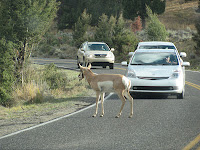 Mammoth if there are no
major animal jams though we did have to wait for some bison and a couple
pronghorn along the way. Rich and
Annette had invited us for dinner but we had told them though we wouldn’t be able
to partake, we would definitely come by for a bit. We got to their campsite around 4:30, declined
the dinner invitation again (though the gentleman who was the night’s chef kept
insisting), and just had a nice visit.
Their campsite is right along the creek among the trees, quite
beautiful and peaceful. While we were chatting, a deer suddenly bolted through the trees running along the creek's edge. We assumed it was being chased and sure enough along came a coyote in full
Mammoth if there are no
major animal jams though we did have to wait for some bison and a couple
pronghorn along the way. Rich and
Annette had invited us for dinner but we had told them though we wouldn’t be able
to partake, we would definitely come by for a bit. We got to their campsite around 4:30, declined
the dinner invitation again (though the gentleman who was the night’s chef kept
insisting), and just had a nice visit.
Their campsite is right along the creek among the trees, quite
beautiful and peaceful. While we were chatting, a deer suddenly bolted through the trees running along the creek's edge. We assumed it was being chased and sure enough along came a coyote in full
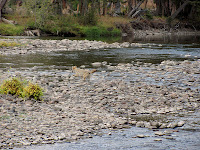 stride.
The deer had bounded across the creek, but the coyote seemed a little
apprehensive about following as he kept running along the shoreline. Evidently he decided it was worth the risk
and shot off across the creek in full pursuit.
Don’t know the outcome but it was cool watch.
stride.
The deer had bounded across the creek, but the coyote seemed a little
apprehensive about following as he kept running along the shoreline. Evidently he decided it was worth the risk
and shot off across the creek in full pursuit.
Don’t know the outcome but it was cool watch.
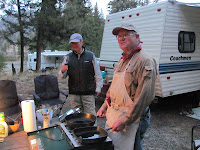 Around 6pm we decided it was time to go and had
walked over to the adjacent campsite with Rich and Annette where dinner was
going to be held so we could say goodbye to everyone who had been nice enough
to come over and introduce themselves to us earlier. Well, as you can guess, our arms were twisted
to stay and eat. Chef Bill would not take
no for an answer! Now keep in mind when
these people camp, we’re not talking hot dogs and hamburgers…they camp in
style! The meal started with appetizers
of baguette slices topped with mozzarella and fresh heirloom tomato slices
drizzled with balsamic vinegar. Along
with
Around 6pm we decided it was time to go and had
walked over to the adjacent campsite with Rich and Annette where dinner was
going to be held so we could say goodbye to everyone who had been nice enough
to come over and introduce themselves to us earlier. Well, as you can guess, our arms were twisted
to stay and eat. Chef Bill would not take
no for an answer! Now keep in mind when
these people camp, we’re not talking hot dogs and hamburgers…they camp in
style! The meal started with appetizers
of baguette slices topped with mozzarella and fresh heirloom tomato slices
drizzled with balsamic vinegar. Along
with
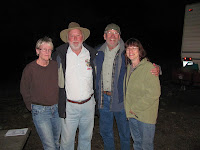 his “assistant”, Scott, Bill sautéed sea scallops and served them on
grilled tortilla triangles topped with a dollop of homemade guacamole and
sprinkled with fresh cilantro…soooo yummy!
There were about 20 people in attendance and plenty of scallops for
seconds! Everyone was so gracious and
they seemed like a fun group. We hated
to leave, but it was getting late and we had to make that long drive home.
his “assistant”, Scott, Bill sautéed sea scallops and served them on
grilled tortilla triangles topped with a dollop of homemade guacamole and
sprinkled with fresh cilantro…soooo yummy!
There were about 20 people in attendance and plenty of scallops for
seconds! Everyone was so gracious and
they seemed like a fun group. We hated
to leave, but it was getting late and we had to make that long drive home.
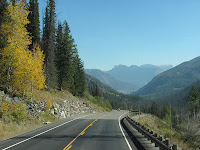 Another place we’d heard so much about and wanted to
visit was the Buffalo Bill Historical
Center in Cody, WY. We decided this was a destination on our way
out of the park via the East entrance.
We had not traveled this road before and the views were
Another place we’d heard so much about and wanted to
visit was the Buffalo Bill Historical
Center in Cody, WY. We decided this was a destination on our way
out of the park via the East entrance.
We had not traveled this road before and the views were
 spectacular plus
we even had a bison escort as we made our way towards the exit!
spectacular plus
we even had a bison escort as we made our way towards the exit!
As we made our way to Cody, we had time to reflect on our wonderful summer in Yellowstone. We made more new friends, had fun with those we had made last year, experienced some incredible
 sites, and were able to share our love of Yellowstone with family and friends who visited. It truly holds a special place in our hearts. Along the way east, we made a quick stop at the Shoshone Canyon overlook with a view of the
Buffalo Bill Dam/Shoshone Project and the tunnels through which we had just
passed.
sites, and were able to share our love of Yellowstone with family and friends who visited. It truly holds a special place in our hearts. Along the way east, we made a quick stop at the Shoshone Canyon overlook with a view of the
Buffalo Bill Dam/Shoshone Project and the tunnels through which we had just
passed.
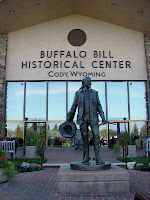 The Buffalo
Bill Historical
Center (http://www.bbhc.org/explore/)
contains 5 museums under one roof.
Founded in 1917, it’s the oldest and most comprehensive museum of the
West and preserves the legacy and vision of Col. William F. “Buffalo Bill”
Cody. We had learned that Yellowstone volunteers did not have to pay the entrance
fee which was a nice bonus. The museums
are the Draper Museum of Natural History (of the Greater Yellowstone area), the
Whitney Gallery of Western Art, the Cody Firearms
The Buffalo
Bill Historical
Center (http://www.bbhc.org/explore/)
contains 5 museums under one roof.
Founded in 1917, it’s the oldest and most comprehensive museum of the
West and preserves the legacy and vision of Col. William F. “Buffalo Bill”
Cody. We had learned that Yellowstone volunteers did not have to pay the entrance
fee which was a nice bonus. The museums
are the Draper Museum of Natural History (of the Greater Yellowstone area), the
Whitney Gallery of Western Art, the Cody Firearms
 Museum (housing nearly 3,000
guns dating back to the 1500s), the Plains Indians Museum (covering the
Arapaho, Lakota, Crow, Cheyenne, Blackfeet, and Pawnee), and of course, the
Buffalo Bill Museum. We spent a little
more than two hours at the complex, and funny thing is that the least interesting
of the 5 museums to us was the one focused on Buffalo Bill. Still it was a very worthwhile trip with so
much to see you could easily spend several hours in each wing. I’ve included only
one photo from each museum in this paragraph and below, but you can view more on their website.
Museum (housing nearly 3,000
guns dating back to the 1500s), the Plains Indians Museum (covering the
Arapaho, Lakota, Crow, Cheyenne, Blackfeet, and Pawnee), and of course, the
Buffalo Bill Museum. We spent a little
more than two hours at the complex, and funny thing is that the least interesting
of the 5 museums to us was the one focused on Buffalo Bill. Still it was a very worthwhile trip with so
much to see you could easily spend several hours in each wing. I’ve included only
one photo from each museum in this paragraph and below, but you can view more on their website.

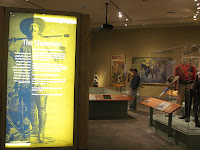 Yellowstone Tidbits:
Yellowstone Tidbits:
*Isa Lake straddles the Continental Divide at an elevation
of 8,262 ft. and drains backwards to both the Atlantic and Pacific Oceans.
*Yellowstone is home to the
world’s tallest active geyser known as Steamboat, which erupts more than 300
feet but with no regularity.
*Yellowstone officials
respond to an average of 700 emergency medical calls each year.
